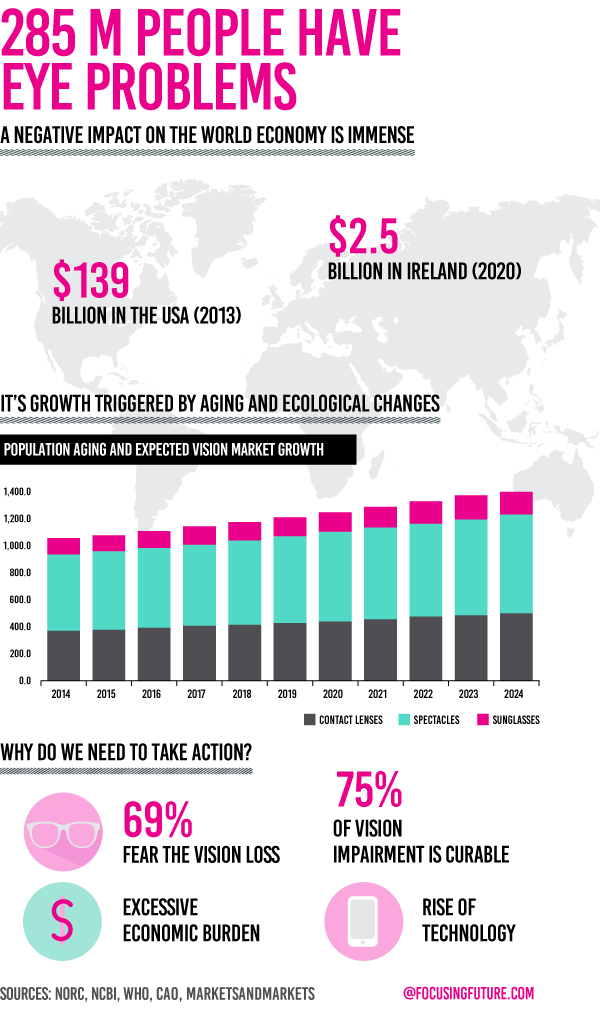![]() 6 minute read
6 minute read
Eye impairment continues to be one of the most important problems having impacts on well-being and creating an economic burden. Today, medical institutions partner up with technology and innovation to resolve them. Projects like Glens, EnChroma, OrCam and eye-gaze technology already take the lead and attempt to empower those, who cannot see well, differentiate colors, or even communicate sufficiently by giving equal opportunities to everyone. Meantime, iPhone 3D face recognition and EyeLock take the concept even further and view eye as an effective biometric recognition tool while embedding safe and innovative reality.
Vision can take
economies down
Today, becoming blind becomes one of the major fears. According to OrCam, more than 285 million people are visually impaired, and every another second somebody loses his/her vision. 69% of Canadians have put vision loss as there number one fear. The issues with vision such as myopia, colorblindness, and eyestrain are highly related to the fluctuations in the demographic features of the population. Eyewear market is growing along with the aging population. For example, economic research conducted in Ireland examines a correlation between aging population and eye impairment, and it is expected to increase the worth of the market up to € 2.5 billion by 2020 in Ireland solely. In combination with ecological issues, this problem will have an adverse impact on other age groups.

Along with effects on quality of living and impact on mental wellbeing, according to Deloitte Consulting, the total economic burden of eye disorders is extremely high. This connection continues to exist since individuals with visual impairment tend to be less productive due to their disability. For instance, in Europe, the most common eye conditions are glaucoma and cataract while being highly prevalent in Italy, Germany, France, UK, Spain, and Slovakia. The situation is similar in the United States, as, in 2013, the total cost of eye vision loss and impairment was $139 billion. 75-80% of these conditions are possibility prevented and cured. Clearly, only development and active investment in cost-effective treatments and interventions can help slow the spread of this medical condition. A combination of these factors illustrates a clear parallel between wellbeing, medicine, and economy, and addressing vision problem becomes now a priority for the companies operating in different business segments.
Enhanced
eyewear
It is widely known that people with hyperopia need to carry and take their reading glasses with them everywhere. Thus, they are always forced to play mind games locating glasses and discover their traces like Sherlock Holmes. An active lifestyle and constant business trips gave a birth to Glens, portable and light reading glasses, in the head of Andrei Ostapenko, its founder. Apart from that, these glasses tend to be invisible and have clear cost benefits while making living more stress-free and convenient. Now, this product has an international presence and diminishes the need to take glasses everywhere while reducing costs and making vision easily accessible.
While Glens try to make eyewear comfortable, products like EnChroma attempt to deal and leave colorblindness in the past. This condition could not be possibly ignored by technology and medical experts, as it has 8% prevalence among men and affects the quality of life in a negative way. EnChroma glasses are able to transfer color and reflect its vibrancy. However, some scientists discovered vision and eyes as not a key focus but merely as instruments themselves.
When eye gets
extra power
Today, apart from the continuous development of health supporting technology, aging continues to be a problem while being accompanied by related diseases such as amyotrophic lateral sclerosis. It is currently considered as incurable and people experience difficulties in movement and communication due to neuronal damage. Steve Thomas did not want to lose the battle to this disease, and he invented eye-gaze technology. This solution allows people with limited hand and speech movement express themselves using a digital board and their eyes. It can be regarded as bright examples of how technology and medical sphere can co-exist not only to enhance the quality of living but also promote social equality.
OrCam is another example of a technological solution that uses technology to offer individuals artificial vision while simply attaching a device to glasses enhances viewing capabilities. This product got $56 million in total funding while this startup is expected to grow rapidly. Other solutions like Esight, GiveVision, Aira[nbsp]show how tech can be integrated into business to enhance vision. Basically, these ideas imply that the world is slowly entering the era of robotics, and artificial intelligence regains its dominant positions in the medical industry. Moving in this direction will truly define future trends and lessen the weight of the economic burden. Meanwhile, the equality along with convenience and ergonomics become keywords in this movement and leading tendencies defining the future of the industry.
Biometric
Identification
To discover the future of vision in more details, all these eye-scans that were always performed by secret agents are now a part of the regular world. Biometric identification becomes an irreplaceable component of our everyday life, and the market itself is projected to reach $21.72 billion by 2022. Today, companies like Apple Inc. use the concepts of facial recognition and want to change to its 3D version soon. Meanwhile, EyeLock already provides iris-based identity authentication for businesses and governments. The major triggers for these changes and innovations are rising concerns about cybersecurity and the need to ensure the safety of the users when not only having day-to-day operations but also when traveling around the world. In addition to that, it is also linked to technological advancement and development in the transportation segment. For instance, autonomous cars will slowly replace other modes of transportation due to their sufficient price-to-quality ratio. It requires paying more attention to cybersecurity, and biometric identification is an idea that can totally resolve it. These changes seem to be rather futuristic, but[nbsp]are in use providing cybersecurity, personalized solutions, and online safety.



